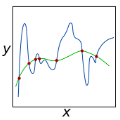A wide range of graph embedding objectives decompose into two components: one that attracts the embeddings of nodes that are perceived as similar, and another that repels embeddings of nodes that are perceived as dissimilar. Because real-world graphs are sparse and the number of dissimilar pairs grows quadratically with the number of nodes, Skip-Gram Negative Sampling (SGNS) has emerged as a popular and efficient repulsion approach. SGNS repels each node from a sample of dissimilar nodes, as opposed to all dissimilar nodes. In this work, we show that node-wise repulsion is, in aggregate, an approximate re-centering of the node embedding dimensions. Such dimension operations are much more scalable than node operations. The dimension approach, in addition to being more efficient, yields a simpler geometric interpretation of the repulsion. Our result extends findings from the self-supervised learning literature to the skip-gram model, establishing a connection between skip-gram node contrast and dimension regularization. We show that in the limit of large graphs, under mild regularity conditions, the original node repulsion objective converges to optimization with dimension regularization. We use this observation to propose an algorithm augmentation framework that speeds up any existing algorithm, supervised or unsupervised, using SGNS. The framework prioritizes node attraction and replaces SGNS with dimension regularization. We instantiate this generic framework for LINE and node2vec and show that the augmented algorithms preserve downstream performance while dramatically increasing efficiency.
翻译:暂无翻译



